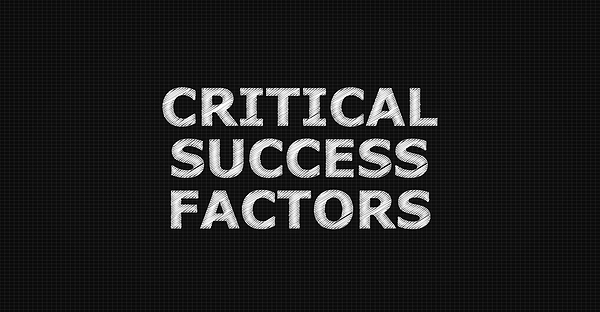Four Critical Success Factors for Your Products
by Brian Lawley,
CEO and Founder, 280 Group LLC
Just build a great product and you’ll take the market by storm, right? That’s the myth perpetuated in Silicon Valley, and it’s a difficult lesson that many entrepreneurs, and seasoned companies, end up learning the hard way. Sure, some products seem to have everything magically fall into place and succeed. The majority of successful products, however, have good planning and execution combined with a great product.
In this article I’ll discuss four factors critical to the success of a product. These factors are based on observations I’ve made during my twenty-year career in Product Management, Product Marketing and while working with dozens of companies in my consulting practice. These factors are discussed, in depth, in my book Expert Product Management.
The first factor for success is building a well thought out, prioritized product roadmap. A high quality product roadmap often means the difference between success and failure when delivering and marketing products. Done correctly, the product roadmap can:
- Guide the engineering and strategic planning efforts of a company.
- Help your company and partners plan and execute more effectively to maximize your marketing efforts and revenues.
- Help win and keep large customers and partners.
- Communicate your vision and where you are headed to press and analysts, giving you added credibility.
- Serve as a very effective tool for helping to raise your next round of funding.
The product roadmap communicates the priorities for the product including what features are being developed, when the different releases will be delivered and the long-term vision for the product. Even if your original product is successfully released, you risk losing focus and delivering the wrong features in a later version unless you have a prioritized roadmap.
You’d be amazed at how many companies we talk with have no roadmaps in place and no process for gathering and prioritizing product requirements. As a result most product roadmaps are created on the fly–and often under pressure– when sales, or the company management, makes a last-minute request. Because they aren’t well thought out they don’t have the impact they should. Such last-minute roadmaps are often the source of trouble because people mistakenly view them as a firm commitment about your plans. You will have a much greater likelihood of success if you learn how to gather requirements, prioritize them, and create a product roadmap in accordance with those requirements. There is a free feature prioritization matrix in the resources section on www.280group.com that can help you with this.
The second factor for success is planning and executing thorough beta programs that ensure complete testing of your products, by real-world customers, prior to their release. This ensures that the product will deliver a good customer experience when it becomes widely available. Running a thorough beta program reduces the risk of releasing a poor-quality product. If that happens, your potential customers may never forgive you and your company may not be able to recover from it.
Beta programs also give you crucial customer testimonials and references that add credibility when you release the product. Having multiple customers who are willing to endorse your product, at launch, dramatically increases your chances of success and of getting press coverage.
Underestimating the amount of time and resources required is the reason most beta programs fail. A good beta program runs for several weeks, allowing customers enough time to install and use the product, provide feedback, upgrade to new versions with bug fixes and use the final candidate software for a few days to ensure no other problems are found. A thorough beta program requires a dedicated person working on it at least half-time for several months to create and execute the plan. Setting goals, locating the right participants for the program, distributing the beta product, gathering ongoing feedback, solving problems that arise and communicating with the beta customers requires a significant amount of work. You should consider hiring a contractor if you do not have adequate in-house resources.
This will ensure that the product is really ready to ship at the end of your beta program.
The third factor for success is planning and running a successful product launch. This process needs to begin at least three to four months prior to the availability of the product. You’ll need that much time to write the launch plan, determine the budget, finalize the positioning and pricing, decide on marketing activities and create all of the deliverables (press kit, white papers, testimonials, brochures, marketing materials, marketing & partner programs, etc.). Going on a press tour two-and-a-half to three months prior to the product shipping will ensure effective press coverage that runs concurrent with product availability. This will allow publications such as magazines, which require a long lead time, adequate time to plan for coverage. You’ll also need several weeks to plan and execute the details of any marketing programs that you plan to run.
Many companies are so focused on getting the product ready to “ship” that they put off planning and executing for the launch until it is too late. We constantly get calls from clients that tell us they have already shipped, or are shipping a fantastic new product in a few weeks, but don’t have the launch activities in progress. The result is that the product becomes available but it doesn’t sell nearly as well as it could have and as a consequence the company doesn’t meet its revenue projections.
Many companies, particularly startups, are unrealistic about what kind of budget it takes to create significant awareness of and demand for their products. For example, one of our clients spent a million and a half dollars on product development and had a forecast for ten million dollars in revenue the first year. When we asked them what they had budgeted for the launch and marketing they indicated that they had budgeted about twenty-five thousand dollars. We had to break the news to them that with this budget they were not likely to generate anywhere near that much revenue. Occasionally there is a product that is so amazing that a company is able to get away with doing little or no marketing. But for the other 99.9% of the products it’s best to be realistic about what you need to spend. After all, if you have risked a million and a half dollars building the product it doesn’t make much sense to try to launch it on a shoestring.
You can do a reality check on your launch budget by using a Return on Investment (ROI) calculator (there is a free one in the resources section at www.280group.com). You enter in the cost for each marketing program, set the assumptions about how many leads it will generate, how many of those will become prospects and how many will close. From there you can use the profit per sale to get an idea of the ROI for each program and how you want to allocate your budget.
The fourth and final success factor is planning and executing an effective product review program. Getting great reviews for your product can be the difference between selling a million units and only selling a few. That’s because reviews carry far more weight and credibility than marketing materials. Reviews are an unbiased (most of the time) reference point that potential customers will rely on to make critical decisions. Very few other factors are as important as getting positive reviews for your products.
Good product reviews can boost your sales significantly. On the flip side, if you receive a terrible product review it may stall or entirely kill product sales. One or two bad reviews and your competitors may steal the whole market from you. And because it is almost impossible to get a publication to reverse their opinion after a bad review is published (or to alert readers to the fact that they have done so), you have to live with the results for a long time.
Companies tend to end up with bad reviews (or no reviews) because they fail to put together a dedicated program for receiving excellent reviews. Too often, the program is an afterthought or it is assigned to a junior person or someone who doesn’t have time to manage it. Then a bad review appears, the company panics and they try to manage the crisis.
It’s easy to increase the likelihood of receiving great product reviews by planning ahead and spending the time and effort to do it right. Provide the reviewer with everything they need (a reviewer’s guide, white papers on the technology, a foolproof demo, FAQs, screen shots, photos, customer references, etc.). Make it as easy as possible for them to have a great experience. Build a relationship with them and be ultra-responsive when they have questions or issues. If you do, they just might cut you some slack when they encounter a problem and not include it in the final article.
Creating a product roadmap, running a beta program, planning a launch and preparing for reviews are critical factors for making your products successful. If you’d like to learn more about any of these factors visit www.280group.com to access free white papers, templates, training materials and toolkits. Or you can purchase a copy of Expert Product Management on Amazon.com.
About The Author
Brian Lawley is the CEO & Founder of the 280 Group (www.280group.com), which provides Product Management and Product Marketing Assessments, Consulting, Training, Certifications, Contractors, Templates and Books. He is also the author of five best-selling books: Expert Product Management, Optimal Product Process, The Phenomenal Product Manager, 42 Rules of Product Management and 42 Rules of Product Marketing.








